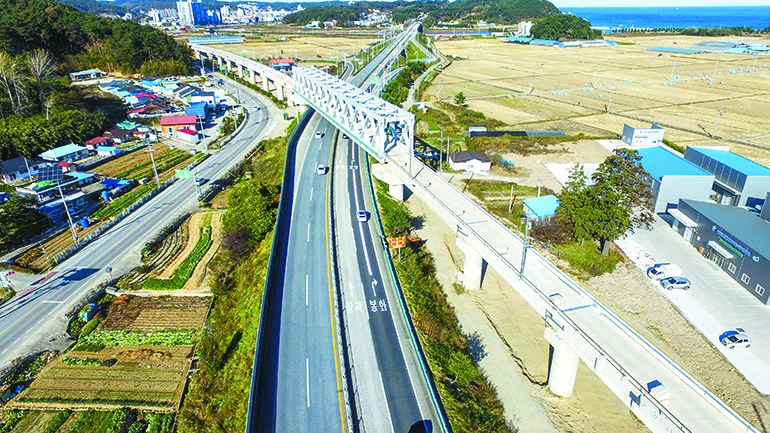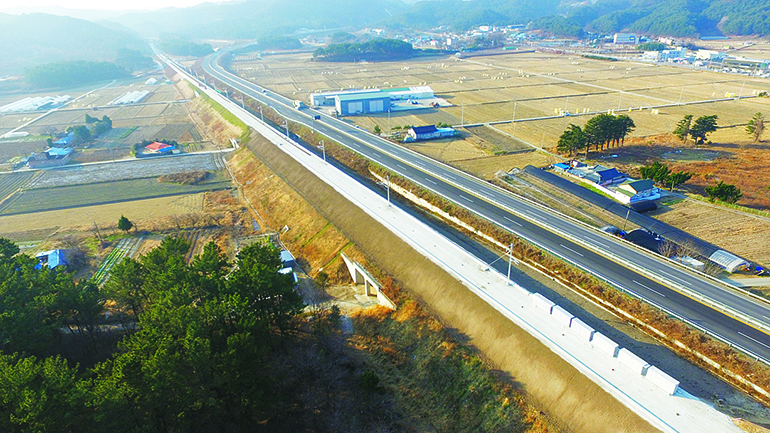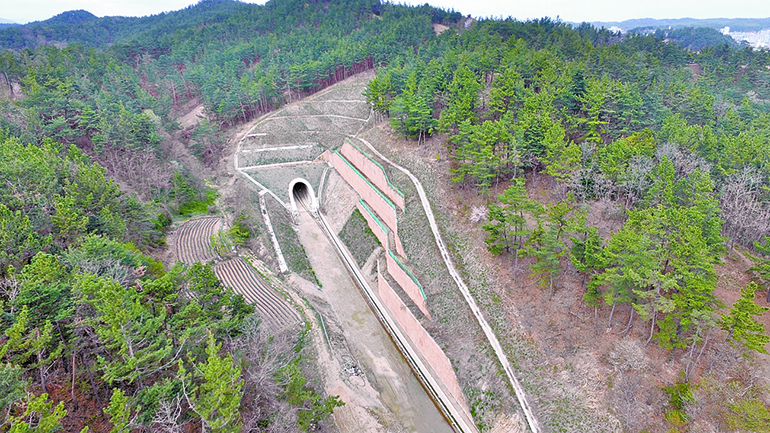
Latest News
- Hyundai E&C Signs PPA for Solar Renewables with Glennmont D&D Solar Holdings
- Hyundai E&C to Embark on UK SMR Project forging Korea-US-UK Technology Alliance
- Hyundai E&C Consolidates Leading Position in Concrete Safety and Quality Technology
- Hyundai E&C Selected as Preferred Bidder for Large Nuclear Power Plant in Bulgaria
- Hyundai E&C Attains “Leadership A” in CDP's Climate Change Assessment
Construction Site of Roadbed of Section 12 of the Donghae Line’s Pohang-Samcheok Railway.
Construction Site of Roadbed of Section 12 of the Donghae Line’s Pohang-Samcheok Railway:
Will Dream of Iron Silk Road Connecting the East Coast of Gyeongsangbuk-do Come True?
A train embracing the beautiful East Sea is ready to embark on its journey. The project for constructing railroad between Pohang and Samcheok on the Donghae Line is nearing its finale of grand opening in December 2023. It is a project focusing on the east coast of Gyeongsangbuk-do, which was only accessible via national route. So not only local residents but also domestic travelers are greatly welcoming this project. Out of the 17 sections, Hyundai E&C is responsible for the construction of 12 sections including building the longest bridge.

[ A panoramic view of Wangpicheon Overpass, a section of truss bridge that crosses National Route 7 (Uljin) ]
The east coast of Gyeongsangbuk-do is not very much accessible for free independent travelers. Other regions in the east coast, like Gangneung, Gangwon-do's representative tourist destination, and Busan, an industrial and tourist city, have long been equipped with highways or railroads. However, the east coast of Gyeongsangbuk-do, such as Yeongdeok-gun and Uljin-gun, remained distant and remote, only accessible via the national route.
The East Sea Line Pohang-Samcheok Railway Construction Project was planned to achieve a balanced regional development, establish a tourism belt on the east coast, and promote inter-Korean exchange and cooperation, laying the foundation for the Eurasian International Railway. It is a mega project of 166.3km (19 stations) in length with a total budget of 3.3 trillion won. It runs north-south along the east coast from Pohang down to Ulsan and Busan, and from Gangneung up to Jejin in Goseong. When the entire section of the Donghae Line is opened, the East Sea axis of the inter-Korean railway from Busan to Rajin Station and Tumen River Station in North Korea will be completed. If additional connections are made to transcontinental railways in Eurasia, the Iron Silk Road, allowing us to travel via rail from Busan to Europe, will no longer be a dream but a reality.

[ Section 1 of the main earthwork at the time of construction ]
Project of Perfect Harmony to be Completed in Upcoming June
As for the Donghae Line Pohang-Samcheok Railway Construction Project, which was ordered divided into 17 sections, Hyundai E&C won 12 sections connecting the entire area of Sanpo-ri, Geunnam-myeon, Uljin-gun, Gyeongsangbuk-do to Onyang-ri, Uljin-eup. It is a project to build four bridges, two tunnels, and a station with a total length of 7.54km and budget of 131.7 billion won. This includes the Uljin Station, the main base station, and Wangpicheon Overpass, the longest bridge among all sections, which drew much attention the time.

[ Section 4 of main line earthwork (view of building panel type retaining wall seen from Uljin Tunnel) ]
The site finalized the design of the bridge in December 2018 and completed the installation of Wangpicheon Overpass and Uljin Overpass in December 2020. After completing the construction of the roadbed for structures and tunnels in December 2021, the roadbeds were transferred to other areas of installing electricity and communication in March this year. The completion ration stands at 95%, and Hyundai E&C is at its last stage of finalizing Uljin Station, the entrance and exit roads to and from the square, and other auxiliary constructions.
Wangpicheon Overpass Finalized Overcoming Unfavorable Conditions
The difficult course in Section 12 was installing Wangpicheon and Uljin Overpasses, which were also the main construction. The truss bridge section of Wangpicheon Overpass is 108m long, 8.4m wide, 10.6m high and has a total weight of 1132t. Truss is a frame structure in which several small-sized components made of steel plates are assembled into triangles, and the truss bridge is a bridge made out of a series of trusses. Hyundai E&C used ILM (Incremental Launching Method), which involves moving and installing bridges using propulsion poles (a kind of rail) to install truss bridges. ILM, also called the “push method” and the “extrusion method,” is a technology that completes the top plate by subsequently pushing (launching) several pieces of upper structures made on land by first, setting up a bridge pier (bridge substructure) and then laying a rail on it. In addition to the mission that it should not interfere with the flow of vehicles on National Route 7 (Uljin), the site used an “automatic measurement system” when working on ILM to meet specific requirements and safety conditions. Thanks to the system, the alignment was precisely adjusted by checking the displacement of each component in real time, and it was possible to successfully install Wangpicheon Overpass, the longest bridge among all sections and the longest among all single-track railway / single spans in Korea.
.jpg)
As much as Wangpicheon Overpass is special for being the longest single-track railway, Uljin Overpass is also special as it has overcome many unfavorable conditions along the way. The arch bridge section of Uljin Overpass is 85m long, which is built at the intersection of local stream called Sansacheon Stream and Local Route 917 (Uljin). Although the site space was very limited, the role of this two-lane Local Road 917 traversing the city of poor transportation, Uljin, was significant. Therefore, the road could not be blocked. Moreover, Sansacheon Stream was often flooded in summer due to lack of surface for water discharge (the passage through which water moves).
The fact that the spaces were too limited to apply the launching gantry or ILM method, which is commonly used for bridge construction, and that the time of construction was a rainy season, conditions were not favorable to the site. Hyundai E&C adopted the Heavy Lifting System to put safety as top priority. Thanks to this special construction method, which lifts structures assembled on the ground and pushes them to the side to mount on the piers, the site was able to increase safety and job performance without having to disturb the road traffic.
.jpg)
[ Completed construction of Namdaecheon Overpass ~ Goseong Tunnel beginning point ]
Another Challenge: Direct Management of All Construction Types
Uljin, where the construction section 12 of the Pohang-Samcheok Railway on the Donghae Line is located, is known for its poor transportation services. This lack of transportation infrastructure slowed regional development, which also adversely affected the progress of the site. From the start of the project, it was difficult for suppliers to supply manpower, materials, and equipment, and finally the earthworks and bridge structure providers gave up construction. After much consideration, the site decided to directly management all types of constructions. The decision was based on the judgment that stable site operation would be possible through direct management of construction. The leaders of the on-site project execution team, direct operation team, and project support team communicated frequently and flexibly operated manpower and equipment through daily and weekly progress meetings. Employees, who became more responsible as much as their increased workload, were committed to implement the process smoothly, by voluntarily expanding their scope of work. The Section 12 was successfully completed, becoming a pilot site for Hyundai E&C’s direct construction operation, and the so much sweat shed by the site workers later became a huge asset of the company.
The site has turned numerous question marks into exclamation marks over the past 85 months. Even though the completion is just around the corner, employees' fighting spirit and teamwork remain unchanged. “We are very proud of contributing to the construction of key transportation hubs in the East Sea,” said site employees, adding that, "We will do our best to ensure the highest quality in a safe environment."

